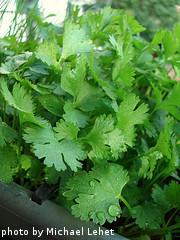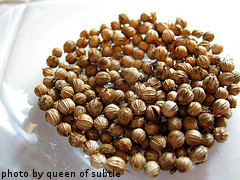How To Grow Cilantro
Questions about how to grow cilantro? You've come to the right place. If you love to make homemade salsa, you should definitely consider growing cilantro in your garden. It's a prolific herb that is easily planted, maintained and harvested. It is unique because you can get two spices from the same plant. The cilantro leaves can be harvested while the plant is still young. After the plant matures, it will produce coriander seeds which also can be harvested and used in a wide variety of recipes.
In all honesty, cilantro usually isn't very expensive to buy fresh at the grocery store. However, lots of times it can be wilted, turning brown and just not very fresh. If you grow your own cilantro, you can cut it right off the plant and use it however you wish. It doesn't get any fresher than that, right? Cilantro that is grown in your kitchen or backyard is usually more flavorful, with more citrus and peppery notes. In our experience, the cilantro we grow is more complex in flavor than the bunches we find in the grocery store.

When growing cilantro, cooler weather is best. You can plant cilantro in the early spring and harvest the leaves before the warm weather of summer arrives. In warm weather, the plant quickly stops producing leaves and focuses its efforts on seed production. Toward the end of the summer, you can plant a second crop of cilantro and the leaves will be ready to harvest before the first hard freeze in the fall.
Cilantro needs at least 6-8 hours of direct sunlight to flourish. The leaves are usually ready to be harvested about 4 weeks after planting. Coriander seeds are usually ready for harvest 6-7 weeks after planting. Cilantro plants grow well with other herbs like basil, mint and parsley. In warmer climates, if the seeds are not harvested, the plants will re-seed themselves and cilantro can be grown year round with minimal effort. Cilantro can be grown in both containers and in the ground.
We typically grow two crops of cilantro. We plant it in our garden in the very late spring and leave it alone until it produces seeds. We wait until the seed pods dry out and the plant is mostly brown and shriveled up. We then harvest the seeds, grind them up and store them in an airtight bag or jar. This is the coriander we use all year long in a wide variety of recipes.
For the cilantro leaves, we grow several plants indoors and time the planting so that the leaves start maturing around the same time as our salsa tomatoes and jalapeno peppers. For a few weeks each summer, we make and eat loads and loads of fresh, homemade salsa, using much of the fresh cilantro that we grow ourselves. We also can a lot of this salsa so that we can enjoy it all year round.
Cilantro leaves are better eaten fresh. If they are dried, they lose much of their flavor. However, they can be frozen in water or blended with butter for long-term storage. Cilantro tastes great with garlic, mint, chives, citrus and cumin. It has a very bright flavor and fresh-cut cilantro fills the room with a wonderful aroma like no other. Cilantro leaves can also be used to flavor oil or as a an ingrediant in a spicy bloody mary cocktail.
Coriander seeds have a somewhat spicy flavor that is even more intense than the leaves. The seeds can be stored for months on end. They can be ground up and used in lots of different dishes.
Here's some options for spice grinders if you're interested...
Quick Overview of How To Grow Cilantro
Planting: Sow seeds 1/4 inch deep in rich soil beginning about 1 month before the last expected frost
Fertilizing: Use roughly balance water soluble fertilizer and apply when watering
Watering: Water the plants a couple of times per week if you don't get any rain, keep soil moist
Harvesting: Pick outer stems when leaves reach desired size for cilantro, wait for seed pods to dry and harvest for coriander
Recipes: Both cilantro leaves and coriander can be used in a variety of dishes and pair nicely with tomatoes, meat, fish, etc...
Did you know that around 8% of the world's population thinks that cilantro tastes like soap? That's because for them, it probably does. The reason for this is genetic. Some folks have a variation in a group of olfactory-receptor genes whereby they strongly perceive the aldehydes in cilantro leaves as tasting like soap. We're glad we don't have this genetic trait.
Click on the following links to learn more about how to grow your own cilantro and coriander.

Click here to learn about planting cilantro
Click here for information about fertilizing and watering cilantro
Click here to learn about harvesting cilantro
Click here for some of our favorite coriander and cilantro recipes
Click here to move from our How To Grow Cilantro page to our Home page